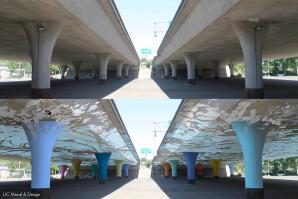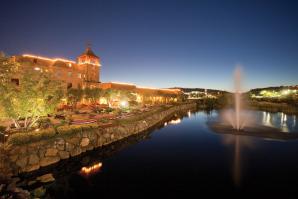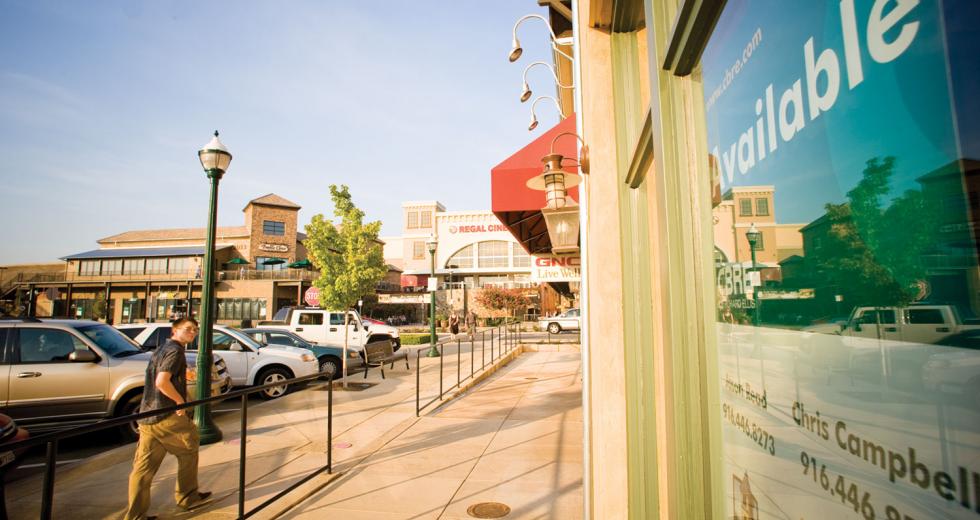No part of the region has been immune to the retail woes that come with a lagging economy, but the Highway 50 corridor — Rancho Cordova, Folsom and El Dorado Hills — entered the slowdown crippled by its own geography.
“The 50 corridor is an interesting dynamic in large part because of the American River,” says Ken Noack Jr., vice president of Grubb & Ellis Co. in Sacramento. “You have limited crossings to a huge demographic area. Between Watt and Sunrise there’s an enormous strip of land people can’t easily access.”
South of 50 is predominantly industrial. There was great hope for new rooftops in that area, but those dreams have been postponed at best. That leaves the corridor sandwiched between the river to the north and a lack of rooftops to the south. In effect, it’s a linear market trying to support a retail economy that traditionally works in geometric circles.
It’s no surprise the corridor has a slightly higher vacancy rate, around 19 percent of 5 million square feet of inventory, and is showing about an 8 to 10 percent drop in rental rates compared to the same time last year.
Even so, the 50 corridor is far from gasping for breath. Overall absorption has been relatively flat (good news in the current economy), deals are being struck, opportunities abound, and the retailers taking up residence, particularly in Rancho Cordova, are targeting penny-pinching consumers.
Rancho Cordova
For years, two primary problems have challenged Rancho Cordova’s
retail sector. First, it’s a city underserved in the kinds of
retail it needs, and second, there’s a leakage problem. Too many
people who live and work there are buying goods elsewhere. City
officials say that’s about to change.
“One big hole we’ve wanted to fill is clothing products,” says Micah Runner, economic development director for Rancho Cordova. “That’s along with electronics and home goods. We’ve wanted some of the national junior boxes that are out there. Our problem hasn’t been the lack of retail; it’s just that the retail we have isn’t what we’ve needed.”
Several big changes may eliminate that problem. Starting with the city’s retail core at the Olson Triangle between Olson Drive, Folsom Boulevard and Zinfandel Drive, Kohl’s opened a new store in the former Mervyn’s space in the fall, bringing clothing and home products. Ross recently signed a lease for a new store in Cordova Town Center, where Target is also revamping its existing space to become a 144,000-square-foot Target Superstore with clothing, groceries and electronics.
All this is coupled with the arrival of new Walgreens and CVS stores; both will provide more basic needs to keep residents local. A new Lowe’s opened last year in Capital Village, and the new Zinfandel Place has attracted several smaller retailers and restaurants. The Mills Center on the corner of Folsom Boulevard and Coloma Road just finished an $8 million facelift, and Nimbus Village recently became the new home of Bridal Mart, to be joined by a supporting cast of wedding retailers.
“Our problem hasn’t been the lack of retail; it’s just that the retail we have isn’t what we’ve needed.”
Micah Runner, economic development director, Rancho Cordova
Given the current economy and how it’s altering consumers’ spending patterns, these changes are transforming Rancho Cordova into the new retail hotspot on the corridor.
“There are some tremendous synergies happening in Rancho Cordova,” Noack says. “You’ve got river crossings at Sunrise and Hazel, and you’ve got stores coming in that provide most of what consumers are still buying. That’s the area where the action’s going to be. Best of all, you can still negotiate some pretty good deals there.”
Indeed, the inherent challenges of the 50 corridor and Rancho Cordova’s higher vacancy rate — due in part to some very large retail holes left by the likes of Sam’s Club and in part to newer developments that still have tens of thousands of square feet available — make it a tenant’s market.
“We’re focused on figuring out how to reposition the exiting retail centers we have to serve the new retail environment we’re in,” Runner says. “It’s all about using our assets to our advantage. Obviously, we’re feeling pretty good about the investment that’s taking place as a result of that. Retailers are showing a clear desire to be here.”
Folsom
If Joe Luchi, Folsom’s director of Intergovernmental Affairs and
Economic Development, had to describe Folsom’s retail sector like
a patient in a doctor’s office, he’d say it’s definitely not
overweight.
“It’s a little lean, but it’s in fairly good shape and holding its own,” Luchi says. “I wish we could say we haven’t been affected by the national economic slowdown, but we’ve felt our fair share of it.”
Two big blows came when Mervyn’s and Circuit City shut their doors nationwide, leaving the city with two large holes in its retail infrastructure that it’s still working to fill. Like cities everywhere, Folsom also lost restaurants and smaller businesses, but it’s weathering the storm.
The most exciting project is Palladio, a 50-acre regional mall on the east side of the city. Original plans called for much of the mall to open by late 2009. Those plans have been pushed back, but there is still progress. Two large anchors have signed on (Barnes & Noble and Whole Foods Market), and a new movie theater is still on track to open this year. Developers are staying somewhat mum on other would-be tenants, but when the mall is fully on line, expected in mid-2011, Luchi says Folsom will be well-positioned to take advantage of the economic upswing everyone is anticipating by late next year.
“Our biggest challenge right now is the regional/national economy and how the state’s plans related to local revenues might limit our ability to promote new development in town,” Luchi says. “Even so, our demographic profile as a city with young, affluent and well-educated residents along with our business-friendly climate, solid infrastructure and our location as a gateway to Lake Tahoe and the gold country will help us continue to grow and prosper.”
“The good news is we have the ability to be patient and intentional about how we fill space. We can take a long-term view.”
Doug Wiele, president, Foothill Partners Inc.
El Dorado Hills
El Dorado may not be known as a retail mecca, but its crown jewel, Town Center, is doing quite well.
“When I think of the hotspots along the 50 corridor, Town Center is on the list. It’s done extraordinarily well,” Noack says. “As a retail center, it’s really coming into its own.”
To understand why, it’s helpful to review a July article in The Sacramento Bee that took a close look at the city of Berkeley.
Berkeley is enjoying retail sales taxes that are going up instead of down, and the city’s retail environment is healthy overall. The reason has to do with the kind of retailers there. Like Town Center, you won’t find the big national chains or franchises; it’s predominantly independents. These are people who depend on their stores for their livelihood. They don’t have the corporate option to pack up and walk away, nor do they have the pressures of meeting stockholder expectations. In a down economy, they fight harder to survive and hang on longer.
“I think we got lucky,” says Doug Wiele, president of Foothill Partners Inc., which, with The Mansour Co., designed Town Center. “We set out to create something different for merchants and consumers by focusing on independents. It’s just an accident of the economy that these kinds of businesses are generally healthier in a down economy, and we’ve got a retail center full of them.”
Adding to its strengths is that it’s not really a shopping center. It’s a mixed-use development that includes offices, car dealers, banks, doctors, dentists and a movie theater. The idea is to create a place where residents can get all their needs met instead of just shopping. As a result, it actually attracts more shoppers.
That’s not to say the economy hasn’t taken its toll here too. Wiele has worked in retail for more than 30 years, and he says this is the worst downturn he’s experienced. Rents are down 5 to 10 percent from last year but holding steady, and Wiele says he’s working hard to make deals. Retailers looking for space that know how to make money in a down market may find an opportunity here.
“We lost our one shoe store. We’d like to backfill that category and get stronger in it,” Wiele says. “We’ve got some terrific women’s boutiques but would welcome more apparel, and we’re working on one more major restaurant and a sports bar. The good news is we have the ability to be patient and intentional about how we fill space. We can take a long-term view.”
Recommended For You

Art Elevated
Local muralists seek to set precedent for public art
Few of the thousands of shoppers at Sacramento’s Sunday farmers market at 8th and W streets ever look up at the gray concrete ceiling looming above them. But by next spring, it may be tough to look at anything else.

Built to Fill
Highway 50 corridor retailers continue to struggle with vacancy
The icy retail climate along the Highway 50 corridor east of Sacramento is slowly beginning to thaw, but an overabundance of standing inventory remains.



